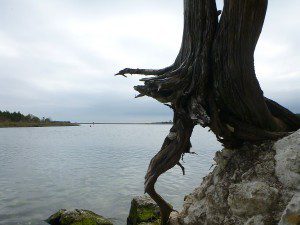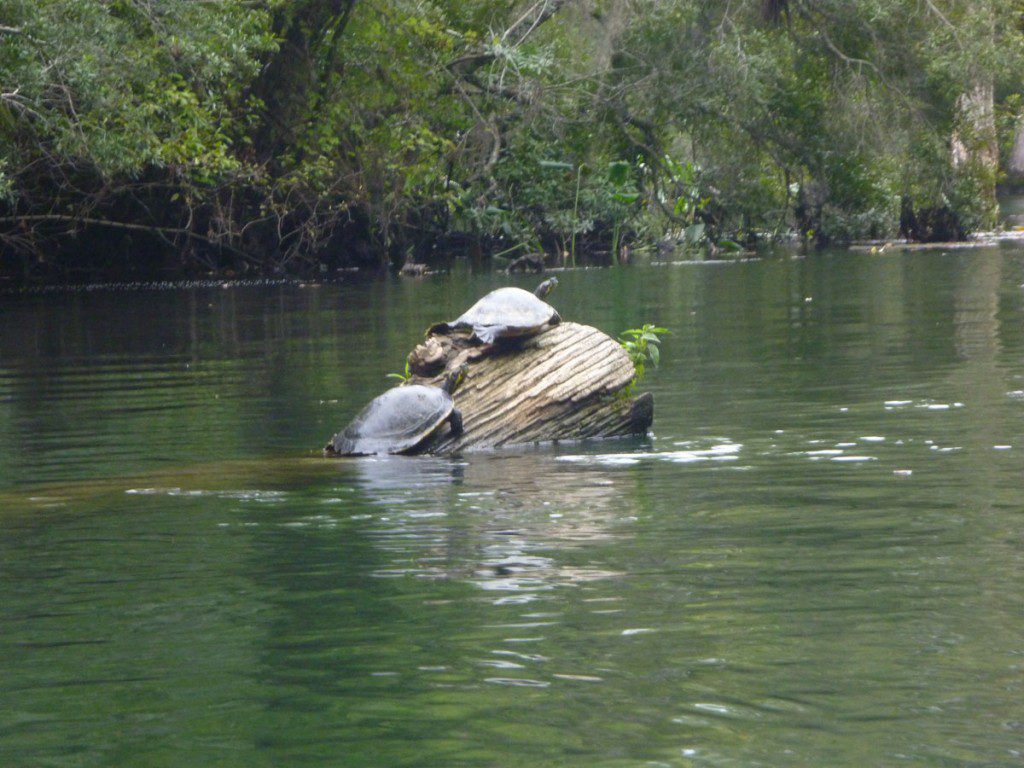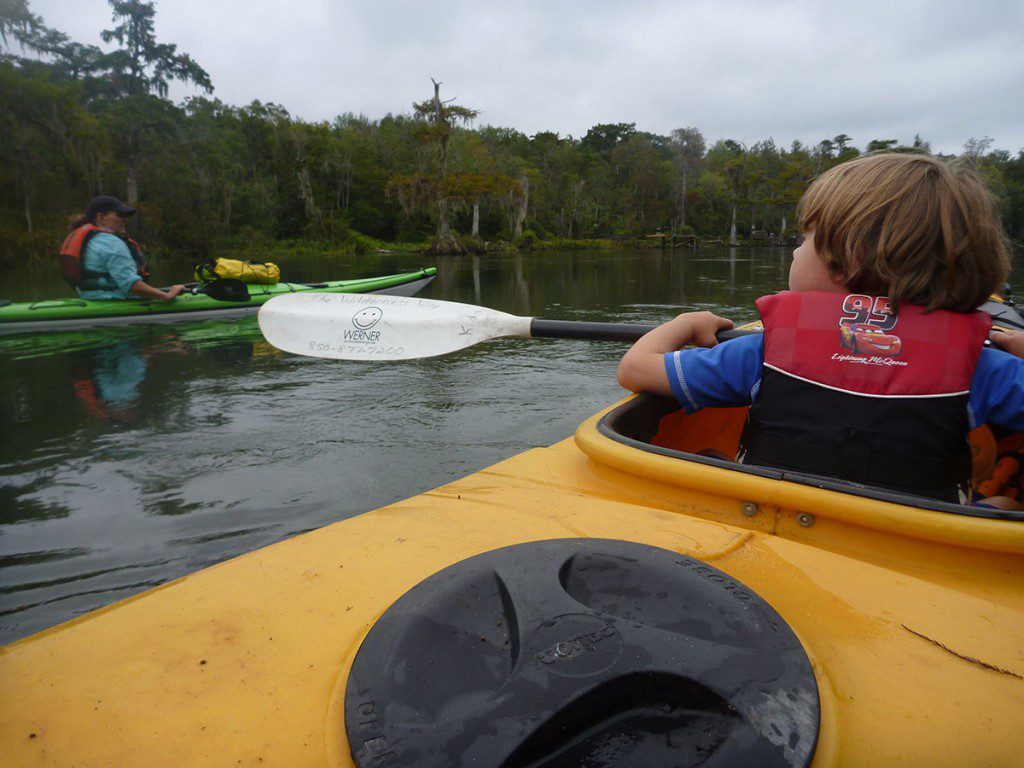Having just finished a video and blog post on Wakulla Springs, WFSU Ecology Producer Rob Diaz de Villegas heads down the Wakulla River with a novice EcoAdventurer. As kid's lives become ever more entwined with technology, many have lost a connection with the outdoors that had once been a staple of childhood. With that in mind, Rob brought his son Max, hoping to build a love of water in him.
Rob Diaz de Villegas WFSU-TV
“Is this the road to the Apalachicola River?” Max asks as we come to the flashing red lights where Highway 98 crosses our path.
“Well, actually, yes,” I tell him. “But today we’re going to the Wakulla River.”
To Max, all rivers are the Apalachicola. For five days in 2012, daddy left home and went kayaking to make some videos on that river. I had left home for conferences and out of town shoots before, but here was something that the then one-year-old Max could understand- daddy was going down a river in a kayak. At the end of that trip, as we rolled into Apalachicola the town, I could make out the shapes of a toddler and an adult walking down the floating dock by Veteran’s Park. It was a sight that ranked up there with Alum Bluff, the Dead Lakes, and Sand Mountain in my mind’s Mount Rushmore of RiverTrek 2012 (an annual fundraiser for the Apalachicola Riverkeeper). I knew then that when he was old enough, I would make the trip with him. We’re not tackling the 106 mile Apalachicola just yet, though. Today, we’re traversing a much more manageable six miles of the Wakulla.
Max and I are on our way to San Marcos de Apalache Historic State Park to meet RiverTrek coordinator Georgia Ackerman and new ‘Trekker Katie McCormick. When we get there, a gaggle of blue shirted volunteer types crowd the entrance.
“Are you here for the Coastal Cleanup?” asks a park ranger as we walked up. Ah yes, Coastal Cleanup Day today.
We have a little time to kill before Georgia shows up with the boats, so I take Max to the convergence of the St. Marks and Wakulla Rivers, which is just off the southern tip of the park. We stand there looking at where the rivers flow into productive marshlands, buoys of all colors bobbing over hidden crab traps. Max sees a way to get down closer to the muddy bank, and I follow him down. I smile at myself for his wanting to get closer to the water, and closer to the muck. That’s why I wanted to bring him today.
A couple of days earlier, the organizers of the Sharing Water Conference came by WFSU-FM to appear on Perspectives. I chatted with them afterwards. These are mostly retired folks; their childhoods perhaps different than those of kids today. “When we were kids,” Jack Carswell said, ” our parents would just send us outside and we’d go play in creeks.” Dr. Anne Holt recalled a recent excursion into Monticello’s new urban forest park, a patch of forest near the center of town. She was walking behind two high school girls doing volunteer work to get the park ready.
“I’m scared. Are you scared?” One girl asked.
“Yes.” the other replied.
Dr. Holt is incredulous. “They’re just a few blocks from the courthouse, and they’re scared.” It’s not news that kids spend too much time on screens, that they don’t exercise enough. And at a time when issues related to climate, water, and ecological resources are at the center of major legislation, voters are becoming more out of touch with the out of doors. That’s why Main Street Monticello Florida made registration to the Sharing Water Conference free, and why they want a younger crowd to take interest.
When I decided to take Max on a kayak trip, I wasn’t necessarily thinking about his one day being a well informed voter when it came to water issues. Not just yet, anyway. I just wanted him to be out there.
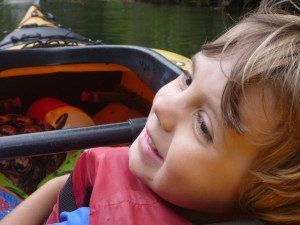 Georgia picked our trip route for the day. At six miles, it would take 2-3 hours depending on our pace. This would give us a little more time than our previous Lake Bradford canoe jaunts.
Georgia picked our trip route for the day. At six miles, it would take 2-3 hours depending on our pace. This would give us a little more time than our previous Lake Bradford canoe jaunts.
On any paddling trip, you have to figure out your shuttling arrangement- whose car is at the put in spot and whose is at the take out, and how do all of the people and boats get back to where they need to go. Paddling with a three year old presents one additional challenge, which is making sure a car seat is wherever Max is. This is why we ended up strapping it to the back of the kayak. My dry bag almost covered it; we had to wrap the rest in garbage bags. Kayaking with a Fred Sanford chic.
Having figured out the car seat question, packing was simple. Plenty of water, plenty of snacks, plenty of sunscreen. And of course a personal flotation device. We shuttle to our put in spot at the upper Wakulla bridge, where another group of coastal cleanup volunteers looks ready to start.
We head out in a tank of a tandem, a good sturdy boat. Georgia gave Max a kid’s paddle, which he initially pokes into the water but mostly just holds. I realize that it had been a year since we had taken Max out on a canoe, before the baby. Then, Max sat in his pregnant mother’s lap. I notice him sitting in the front cockpit by himself, and I notice that he isn’t his usual animated self.
“The kayak’s wobbling,” he says.
“It’ll do that a little,” I tell him. But this kayak really is a big, heavy vessel. I see a motor boat coming up ahead, and I warn Max so that the wake won’t startle him. The ripples barely move us.
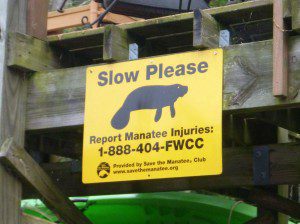 Moving down the river, we see signs posted from people’s docks asking motor boats to slow down for manatees. I have told Max that seeing them is a possibility, reminding him that we’ve seen them on the Wakulla Springs boat tour and that this is the same river. But I don’t want to get his hopes up.
Moving down the river, we see signs posted from people’s docks asking motor boats to slow down for manatees. I have told Max that seeing them is a possibility, reminding him that we’ve seen them on the Wakulla Springs boat tour and that this is the same river. But I don’t want to get his hopes up.
After about an hour, we approach the 98 bridge, this time from the water. Georgia tells us that this is a good spot for a bathroom break. Before the bridge there is a man in what looks like a kid’s kayak, his toes dangling in the water. He’s smoking a cigarette. I speed up to get Max past the smoke.
When we get to the other side of the bridge, I park the boat and ask if he has to go.
Don’t I know any better? Before bed, before school, or before a car trip, I don’t ask. I tell him that it’s time to go. But this time, I ask, and he says “No.”
“Are you sure?”
“Yes.”
The man in the small green kayak comes up. “I’ve been out here since four,” he says.
“See any manatees?” We ask him.
“I saw five, a family of five.”
“Nice!”
“Do you have a personal flotation device?” Georgia asks.
“I’m an adamant swimmer,” The man says.
“By law you’re required to wear one when you’re on the water. FWC is patrolling, and you’ll get fined. I’m not trying to bust your chops, I just want you to know.”
The man is unfazed by Georgia’s warning. As we paddle away, she says “Being an ‘adamant’ swimmer doesn’t do you any good if you get knocked unconscious.”
We paddle another half-an-hour and Max says. “I have to go to the bathroom.” This was entirely predictable. We find a spot for him and I try to get him to go, but he won’t. He holds it, and doesn’t mention it again.
There’s not too much for him to do in the kayak. We have little chats. I mention birds I see- a cormorant swimming, a kingfisher attacking the water. He doesn’t say anything. He starts looking a little drowsy. His little brother has been waking up in the night, crying. First tooth. None of us has slept well.
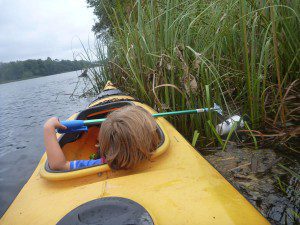 Then he sees Katie pickup a Natural Light can, and he’s filled with purpose. Georgia has given him a pick-up tool, a pole with a claw, for Coastal Cleanup Day. I steer us close to the riverbanks to look for trash. We don’t see any. “When the river gets high, the trash gets pushed off the shorelines,” I tell him. When I see a styrofoam cup in some tall grasses, it’s a small relief.
Then he sees Katie pickup a Natural Light can, and he’s filled with purpose. Georgia has given him a pick-up tool, a pole with a claw, for Coastal Cleanup Day. I steer us close to the riverbanks to look for trash. We don’t see any. “When the river gets high, the trash gets pushed off the shorelines,” I tell him. When I see a styrofoam cup in some tall grasses, it’s a small relief.
The cup is really in there though, and the little grabber keeps catching grass. I worry that we’ll do more damage than good getting it out, but I also know how upset he’ll be if we leave it there. I knock the cup closer to Max with my paddle, and he grabs it. He’s done a tiny something to clean up the river. All that’s left is to see a manatee.
And we do. Sort of. Katie spots a mother and a calf right by her kayak, under the water. We all start to paddle backwards against the current to see if we can spot them again, and we do see them surface briefly upriver. They’re much faster than you would expect. And then, a little closer to St. Marks, as we start seeing buoys again, a small dolphin pops up ever so briefly. The dolphin senses that it’s surrounded by food, but the food is stuck in a most inconvenient package.
These are our encounters with the marquee sightseeing animals. That’s often how it goes; we see these brief flashes of the “cool” animals. Sometimes we get more. The trip is not about manatees or dolphins. We can go to an aquarium for that. We’re here to experience a river.
When we get back to San Marcos de Apalache, Max is back to running around. He seems more awake. His trip has amounted to picking up a styrofoam cup, falling asleep, holding his pee, and not quite seeing the cool animals the adults are talking about. It’s hard to gauge how much he really enjoyed the day. I leave a little disappointed. For two years, he’s had this mythical idea about the amazing adventures you can have while kayaking a river. I felt like I had burst that myth.
But then later, he’s talking about wanting to go kayaking again, and camping. He wants to go to the Apalachicola.
I remember him as a baby on walks, staring at trees. Max, like his brother is now, was an interactive baby. He paid very close attention to adults, and was always responsive when we talked to him. Except on walks. Reclined in his stroller, he’d stare up at the canopy of trees overhanging the sidewalk, barely noticing us. He had long stretches of stillness on the river as well, and I’d wonder, “Is he bored?” But he has a way of taking things in, this kid. At one point he called a cypress tree “beauty-ful.”
Like it or not, this kid has years of kayak, hiking, and camping trips ahead of him. I accept that he may not grow into a person who loves nature like I do. But if he doesn’t, it won’t be because his parents didn’t expose it to him.
A few things I learned about paddling with a small child:
- Pick a stress free trip. Pick a river/ lake you know (or in my case, go with a person who knows it really well, or plan a trip with an outfitter). You want to be able to focus on your child’s comfort and enjoyment. The goal, at least my goal, is to give them a taste of these activities.
- Pick a shorter trip with opportunities to stop. Before this trip, I had taken Max to Lake Bradford a couple of times, renting a canoe cheaply for an hour and taking him past the panther enclosure at the Tallahassee Museum. Today’s trip was longer but there was an opportunity to stop (even if I didn’t properly take advantage).
- Bring water & snacks, and keep them accessible. I packed the snacks far up in Max’s cockpit, and when he wanted his banana, he had to reach the snack bag with his feet and kick it to himself. Bad Daddy!
- Personal flotation device. This is obvious for a child, and as Georgia mentioned, is required of everyone.
- Shuttling with a car seat. If you have an extra, that’s best. Or you can take a round trip. Or, you know, what I did.
- Toys/ activities. This is one I struggled with, as I didn’t want to bring anything that would get dropped. Georgia brought the pick up tool and a water squirter. I have some different ideas for the next trip, which is hopefully next week. What other kinds of toys have any of you brought for kids on longer trips?
- Have fun. I wanted Max to try using his paddle a little more, but I wasn’t going to push him. The last thing I need to do is turn him off of paddling.

